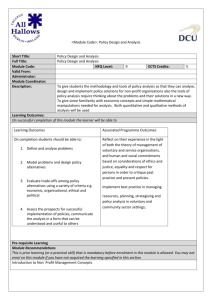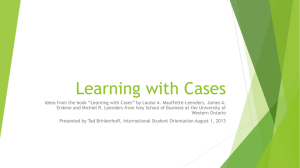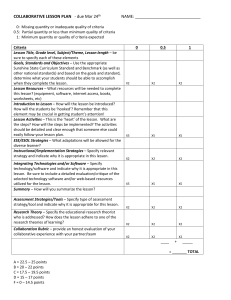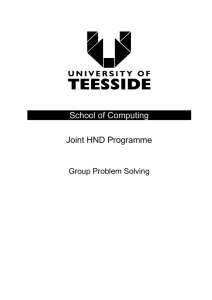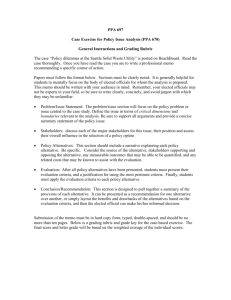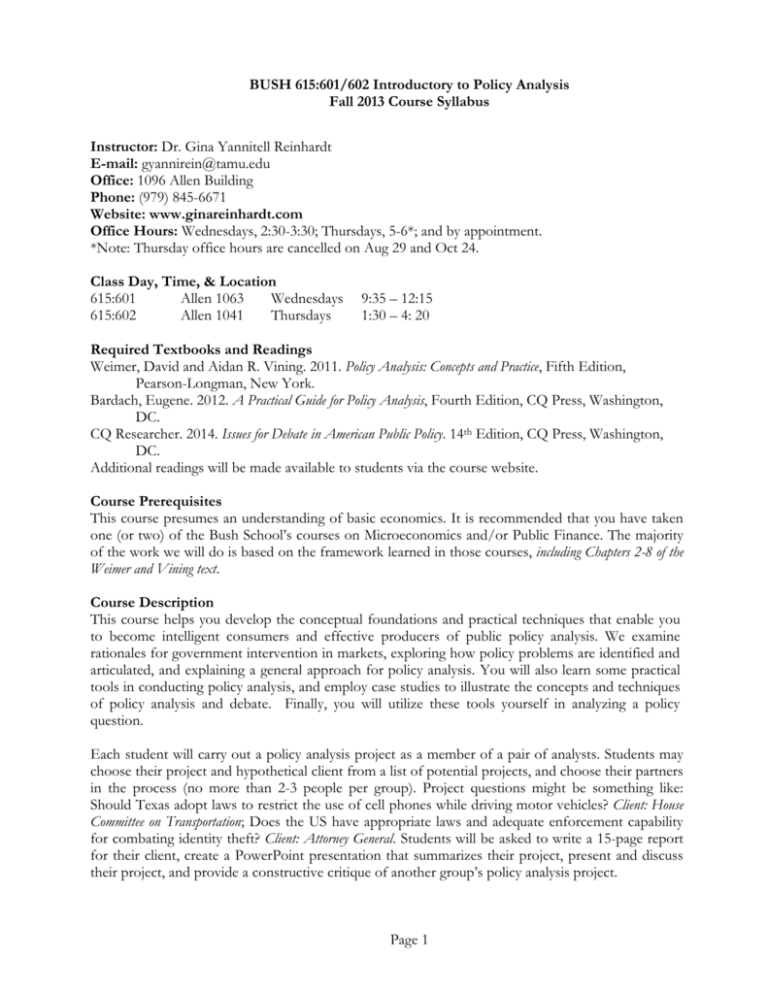
BUSH 615:601/602 Introductory to Policy Analysis
Fall 2013 Course Syllabus
Instructor: Dr. Gina Yannitell Reinhardt
E-mail: gyannirein@tamu.edu
Office: 1096 Allen Building
Phone: (979) 845-6671
Website: www.ginareinhardt.com
Office Hours: Wednesdays, 2:30-3:30; Thursdays, 5-6*; and by appointment.
*Note: Thursday office hours are cancelled on Aug 29 and Oct 24.
Class Day, Time, & Location
615:601
Allen 1063
Wednesdays
615:602
Allen 1041
Thursdays
9:35 – 12:15
1:30 – 4: 20
Required Textbooks and Readings
Weimer, David and Aidan R. Vining. 2011. Policy Analysis: Concepts and Practice, Fifth Edition,
Pearson-Longman, New York.
Bardach, Eugene. 2012. A Practical Guide for Policy Analysis, Fourth Edition, CQ Press, Washington,
DC.
CQ Researcher. 2014. Issues for Debate in American Public Policy. 14th Edition, CQ Press, Washington,
DC.
Additional readings will be made available to students via the course website.
Course Prerequisites
This course presumes an understanding of basic economics. It is recommended that you have taken
one (or two) of the Bush School’s courses on Microeconomics and/or Public Finance. The majority
of the work we will do is based on the framework learned in those courses, including Chapters 2-8 of the
Weimer and Vining text.
Course Description
This course helps you develop the conceptual foundations and practical techniques that enable you
to become intelligent consumers and effective producers of public policy analysis. We examine
rationales for government intervention in markets, exploring how policy problems are identified and
articulated, and explaining a general approach for policy analysis. You will also learn some practical
tools in conducting policy analysis, and employ case studies to illustrate the concepts and techniques
of policy analysis and debate. Finally, you will utilize these tools yourself in analyzing a policy
question.
Each student will carry out a policy analysis project as a member of a pair of analysts. Students may
choose their project and hypothetical client from a list of potential projects, and choose their partners
in the process (no more than 2-3 people per group). Project questions might be something like:
Should Texas adopt laws to restrict the use of cell phones while driving motor vehicles? Client: House
Committee on Transportation; Does the US have appropriate laws and adequate enforcement capability
for combating identity theft? Client: Attorney General. Students will be asked to write a 15-page report
for their client, create a PowerPoint presentation that summarizes their project, present and discuss
their project, and provide a constructive critique of another group’s policy analysis project.
Page 1
Learning Outcomes:
By the end of the semester, you should be able to:
Demonstrate an understanding of key concepts and methods of policy analysis.
Demonstrate the fundamental skills of written communication.
Define policy problems.
Demonstrate how policy analysis facilitates a choice among policy alternatives.
Discuss the role of policy analysis and the policy analyst in government and the non-profit
sector.
Professional Expectations
A part of graduate study is learning to learn from every possible source – from readings, peers, life
experiences, the instructor, and research projects. The excellence of each student’s preparation,
assignments, and participation in reasoned, thoughtful discourse in class drives the success of the
learning experience, and ultimately each student’s grade. Each student and his/her contributions
should be treated with respect, and no student should feel marginalized, minimized, or otherwise
discriminated against. Being in class on time and prepared to contribute, as well as actually
contributing are signs of respect for fellow students and your commitment to the graduate learning
process. The instructor will directly counter any unprofessional or disrespectful activities.
COURSE REQUIREMENTS AND GRADING
Your attendance and active participation is expected. The material we cover is challenging, and
classroom discussion is essential to fully understand the concepts and techniques contained in the
readings. I expect that your participation will reflect your careful consideration of assigned readings.
Quality contributions to class discussion include asking questions, offering opinions, careful
listening, and consideration and respect for the opinions of your classmates. A simple cost-benefit
analysis will indicate that class attendance and participation are well worth the effort (i.e., unless you
attend regularly, you are very likely to fail this class). Several components will determine each
student’s final course grade, described below:
1.
2.
3.
4.
5.
6.
Discussion Leader (10 points)
Active Participation (15 points)
Homework Assignments (28 points)
Policy Analysis Project Report (25 points)
Project Presentation (12 points)
Critique of Peers (10 points)
Earning 100 points will be considered perfect performance for this course. Grades will be allocated
based on your earned points. There is no extra credit for this course.
Homework Assignments (28 points)
All of the homework assignments will focus on the student’s policy analysis project. Students will
complete four homework assignments, each of which is worth one-fourth of the homework grade:
1. Policy Brief (2-3 pages and presentation; 7 points)
2. Annotated Bibliography (5-7 pages; 7 points)
3. Political Feasibility Homework (2-3 pages; 7 points)
4. Goals and Alternatives Matrix (2-3 pages and presentation; 7 points)
Homework Assignments #1 and #2 are to be your own independent written work. Your policy brief
presentation may take place in groups, and your group may coordinate which sources are annotated
by which group members, to avoid overlap. Homework Assignments #3 and #4 are to be the joint
work of your project team.
Page 2
Critique of Peers (10 points)
During the last class sessions, students will present their project reports to the rest of the class. Each
student will be randomly assigned to write a 1-page critique of one of the project reports presented
by a fellow classmate.
Late Work Policy
Late assignments will not be accepted. Early assignments will always be accepted. If you find
yourself in a situation where you cannot make it to class and cannot give your homework to a
colleague to turn in for you, you may email the homework to me, along with an explanation for why
you are not in class. Otherwise, you are expected to attend class and turn it in yourself.
Your final project is due at 11:00am on Tuesday, December 10, 2013. If you turn in your project
on December 10th after 11:00am, you will be penalized 1.5 points. From then on, until you turn in
your project, every time the clock strikes midnight, you will be penalized 1.5 more points.
TAMU email account
Students must have a TAMU email account. I will often send out class announcements, reminders, or
logistical instructions using this email system. You are responsible for making sure that your TAMU
account is current and working.
Grading Standards:
All grades are dispensed using the following scale:
90-100 points:
80-89 points:
70-79 points:
60-69 points:
60< points:
A
B
C
D
F
- Extraordinary, excellent work and mastery of concept
- Good work and solid command of concept
- Adequate work and sufficient understanding of concept
- Poor work, little understanding of concept
- Lack of work, no understanding of concept
Honor Code
Every student is expected to adhere to the Aggie Honor Code:
An Aggie does not lie, cheat, or steal or tolerate those who do.
If you are found guilty of plagiarism or cheating, you will fail the assignment, you will probably fail
the course, and you will likely be recommended for expulsion. If you have any questions about
Honor Council Rules and Procedures, you may find more information at http://www.tamu.edu/
aggiehonor.
Students with Disabilities
The Americans with Disabilities Act (ADA) is a federal antidiscrimination statute that provides
comprehensive civil rights protection for persons with disabilities. Among other things, this
legislation requires that all students with disabilities be guaranteed a learning environment that
provides for reasonable accommodation of their disabilities. If you believe you have a disability
requiring an accommodation, please contact the Department of Disability Services in Cain Hall, call
845-1637, or email disability@tamu.edu.
Page 3
COURSE SCHEDULE
WEEK
FIRST HALF
Week #1
(8/28 or 8/29)
Introductions and Project Assignments
Week #2
(9/4 - 9/5)
The Foundations of Policy Analysis
Instructor Notes, online .pdf
Weimer and Vining (W&V): Ch. 1 & 2
Week #3
(9/11 – 9/12)
DUE:
Policy Briefs
Week #4
(9/13 – 9/14)
Week #5
(9/25 – 9/26)
DUE:
Annotated
Bibliography
Week #6
(10/2 – 10/3)
Week #7
(10/9 – 10/10)
Policy Brief Presentations
DISCUSSION LEADERS
SECOND HALF
Elements of a Policy Debate
Presenter: Sally Dee Wade,
Writing Consultant
Topic: How to Write a Policy Brief
READINGS/ASSIGNMENTS
Read: W&V Ch. 1
Read & Outline: W&V Ch. 1
Go over the case study and outlines from W&V Ch. 1
Current Issues in Public Policy
Foreign Affairs
National Security Policy
CQ Researcher:
Ch. 1: Rising Tension Over Iran
Ch. 2: Foreign Aid and National Security
Policy Brief Presentations
Everyone Presents
The Eightfold Path
Bardach: Part I & II
W&V: Ch. 14
1._____________
Current Issues in Public Policy
Social Policy
Policy Options
W&V: Ch. 9 & 10
Bardach: Appendix A & B
1._____________
2._____________
Professional Development:
Networking and Finding
places to Apply
Adoption and Implementation
W&V: Ch. 11-13
Bardach: Appendix D
1._____________
Current Issues in Public Policy
Business and the Economy
Cost Benefit Analysis (CBA)
Analysis
Instructor’s Supplemental Notes
W&V: Ch. 16, pgs. 383-399
1._____________
2._____________
2._____________
2._____________
Current Issues in Public Policy
Social Policy
Everyone Presents
CQ Researcher:
Ch. 11: Immigration Conflict
CQ Researcher:
Ch. 12: Gay Marriage Showdowns
CQ Researcher:
Ch. 8: Financial Misconduct
Professional Development:
Resumes and Cover Letters
CBA Class Exercise #1
Current Issues in Public Policy
National Politics
Page 4
CQ Researcher:
Ch. 3: Farm Policy
Week #8
(10/16 –
10/17)
Discounting and Risk
W&V: Ch. 16, pgs. 399-423
DUE:
Political
Feasibility
Statistical Analysis
W&V: Ch. 17
Week #9
(10/23 –
10/24)
Goals, Criteria, and Policy Alternatives
W&V: Ch. 15
Week #10
(10/30 –
10/31)
1._____________
2._____________
1._____________
Current Issues in Public Policy
Foreign Affairs and National
Security Policy
2._____________
Current Issues in Public Policy
Foreign Affairs and National
Security Policy
Everyone Presents
Goals and Alternatives Matrix
Presentations
CBA Class Exercise #2
CQ Researcher:
Ch. 15: Unrest in the Arab World
CQ Researcher:
Ch. 16: Privatizing the Military
Meetings with Professor on 10/30 and 10/31
Week #11
(11/6 – 11/7)
DUE:
Goals &
Alternatives
Matrix
Week #12
(11/13 –
11/14)
Goals and Alternatives
Matrix Presentations
Ethics and Policy Analysis
W&V: Ch. 3
Bardach: Part III
1._____________
Professional Development:
Conduct in the Workplace
Everyone Presents
First Group Presents Final Report in Thursday
Section
2._____________
Week #13
(11/20 –
11/21)
Project Presentations
Teams: #1, #2, and #3
Project Presentations
Teams: #1, #2, and #3
Week #14
(11/27 or
12/3)
Project Presentations
NOTE: Assign Students to Peer Critique
Teams: #4, #5, and #6
Project Presentations
Teams: #4, #5, and #6
Week #15
(12/10)
Final project report and peer critique due
at 11am on December 10, 2013
Page 5
Thoughts when you Read and Prepare to Participate
Some subjectivity in evaluating your participation will be irreducible; this will also be the case when
evaluating any policy analysis situation in your life. I will, however, try to follow the basic rubric
below when assessing your participation grade. Since participation is worth 15% of your overall
grade, it is important for you to be aware of how well you are participating every week. Keep in
mind that you do not begin with a full stock of participation points that get whittled away if you
commit transgressions (like falling asleep in class or chatting with friends on facebook). Rather, you
must build up points by actively engaging in class. If you feel it is difficult to participate, you can
prepare talking points ahead of time to work into the discussion, or post links, questions, or
discussion points on elearning. With several people in class, it may take some guts to get your point
in, so be assertive – you don’t want your grade to suffer, and we want your input!
Points
Out of 20 possible points, your participation will be assessed as follows:
- Give criticisms/comments on the readings that illustrate careful reflection
- Reference suitable material from outside class (events, news, experience)i
- Reflect on class activities and how they relate to our pursuit of policy
13.5-15
analysis, and/or our understanding of the readingii
- Engage in class activities and discussion through volunteering to speak,
lead groups, answer questions, read excerpts, etc.
- Ask about confusion, problems, etc., or point out issues of contention
12-13.5
- Raise points of interest from the reading
- Come to class on time every day (or make up class properly)
- Speak when called upon and participate in activities when told what to do
- Use facebook, IM, emails, games, etc., when not actually speaking
10.5-12
- Pass notes/computers back and forth with classmates
- Come to class late, disrupt discussions, miss class without making up
Below 10.5
- Eat starburst™ in class or wear capes
Making up Participation for a Missed Class Meeting:
Keep in mind that missing a class meeting for us is missing an entire week of class – 2 meetings for a
standard course. To make up this participation, you should find an outside lecture (on campus, in
the Bush School, online) to attend that is relevant to a policy or policy analysis you find interesting.
Write a one-page paper about what you learned and how it pertains to our course and what we are
learning. Turn it in to me within two weeks of missing class.
NOTE: This is only acceptable for absences that have been excused by me or by the university.
i
You may also start discussions on elearning. Post articles (eg, from the Financial Times or New York Times) that pertain to class topics, and comments
with the link. Bring up your article during class.
ii These reflections can also be submitted on elearning, as discussion posts, after class .
Page 6
Policy Brief - Guidelines and Rubric
(2-3 pages and presentation; 7 points)
One Brief per Person
One Presentation per Policy Group
Imagine your client/boss has just come to you with your policy question and said, “Please give me a
brief on this in a week.” Briefs are short, succinct, informative documents that convey the most
essential elements on an issue. You should strive for a succinct presentation of information that
would be helpful to a client, informing him/her of the basic policy problem and the paths you
intend to take to address that problem. You have one week to collect the basic information that
outlines these essential elements to your client. Your brief might present, or foreshadow, the areas
your policy project will explore over the semester (background, potential evaluation criteria, key
players, alternatives, etc.). Extra kudos will given to those students who delve into the dimensions of
the policy goals and discuss how those particular goals/dimensions will be affected by factors
specific to the policy problem.
Remember two main things about this assignment:
o Your client has a short amount of time to read this information.
o You need to be as informative as possible about your topic.
Each sentence you use must be vital to your point. Nothing is extraneous. There is no fluff.
It is important to note that you do not have to commit yourself to any particular strategy or
viewpoint at this time. Although sometimes you might be drafting a policy brief for your boss in a
Congressional office, and you would know the political leanings of that boss, in our case this policy
brief does not have a particular political stance. If you suggest in your brief that you will set forth 3
policy alternatives (A, B, and C), and you decide later that you will instead analyze three different
alternatives (D, E, and F), that is acceptable. If you state in your brief that your project will conclude
that alternative B is best, that is NOT acceptable – if you already know the outcome, what is the point
of the analysis?
Grading Rubric (total points possible: 7)
Presentation (2 points)
1 point: overall quality and appearance
1 point: professionalism (typewritten, heading, no typographical errors, clean, good grammar)
Organization (1 point)
1 point: Logical flow, including (if necessary): headings, bullet points, introduction, conclusion
Content (4 points)
3 points: information on policy issue, plan of research/evaluation, relevant
players/groups/individuals
1 point: all facts that are not common knowledge must be properly cited. News outlets are
permissible for opinion-related information; government sources are suitable for reports or
agency-related facts; other information should come from academic sources.
Page 7
Annotated Bibliography - Guidelines and Rubric
(5-7 pages; 7 points)
One Annotated Bibliography per Person
No overlapping sources within a Policy Group
An annotated bibliography is a list of citations to sources such as books, articles, and documents.
Each citation is followed by a brief (usually 150-300 words) descriptive and evaluative paragraph, the
annotation. The purpose of the annotation is to inform the reader of the relevance, accuracy, and
quality of the sources cited.
You might think of each annotation as consisting of 3 main points:
o Summary: What are the main arguments? What is the point of this book or article? What
topics are covered? If someone asked what this article/book is about, what would you say?
o Assessment: Is it a useful source? How does it compare with other sources in your
bibliography? Is the information reliable? Is this source biased or objective? What is the goal
of this source?
o Reflection: How does this source fit into your research? Was this source helpful to you?
How does it help you shape your argument? How can you use this source in your research
project? Has it changed how you think about your topic?
Requirements:
o 5-7 pages in length (single-space each annotation, you may have double space between
sources)
o At least 8 total sources
o At least 4 of those sources must be “scholarly” in that they are either:
Peer-reviewed journal articles
Peer-reviewed books
Government documents
o The remaining 4 “non-scholarly” sources may be from sources such as Congressional Quarterly,
newspapers, the Economist, interviews, NGO websites, think tanks, etc.
There are several schools of style – APA, MLA, etc. You may choose any citation style you wish, as
long as you are consistent across all entries in your bibliography.
You may include more than 8 sources if you wish for extra feedback. Only 8 entries will be graded.
Grading Rubric (total points possible: 7)
Presentation (2 points)
1 point: overall quality and appearance
1 point: professionalism (typewritten, heading, no typographical errors, clean, good grammar)
Organization (1 point)
1 point: summary, assessment, and reflection for at least 8 sources
Content (3 points)
3 points: summary, assessment, and reflection for at least 8 sources
Style (1 point)
1 point: consistent style and complete citation for each source (MLA, APA, or any style is
acceptable)
Page 8
Political Feasibility Homework - Guidelines and Rubric
(2-3 pages; 7 points)
One Assignment per Policy Group
No Presentation to Class
Your client/boss will always need to know the feasibility of a policy alternative’s adoption. Sometimes your
client will be excited about a policy that has no chance of adoption, and it will be your job to give the client
the bad news. Other times, the most feasible option is also the least exciting. Therefore, it is important for
any policy analysis to include an analysis of each policy’s political feasibility. What are the chances that each
policy will be adopted? This feasibility analysis will ultimately serve as the foundation for the information that
undergirds the “political feasibility” row in your goals/alternatives matrix.
Before you create that “political feasibility” row, however, you need to know the actors relevant to your
policy issue. What are their motivations and beliefs, and what resources do they have to use? These actors,
and their motivations, beliefs, and resources, will not change, regardless of the policy alternatives you are
considering. Their position or actions may change depending on the policy alternative, but their motivations,
beliefs, and resources will not. Therefore, you can make a clear analysis of the political backdrop of your
policy issue from which to analyze each alternative. Clarifying that political backdrop is the purpose of this
assignment.
Technicalities
o
o
o
o
o
Each policy group needs to turn in only one Political Feasibility assignment.
One page of your political feasibility homework should look very similar to the chart given in Weimer
and Vining (W&V) that is called “A Political Analysis Worksheet” (Table 11.2; page 276).
Extra page(s) of the assignment should include any cited works, interviews, or other documents from
which you got your information. Not every item in the table will need a citation, because some of them
will be conclusions or analyses that you draw. You may also include extra pages explaining items in
particular cells, if you feel that clarification is necessary. But in the end, the chart should be able to stand
on its own in terms of explaining what you have learned about the actors relevant to your policy project.
Your worksheet should have at least 4 columns: Actors, Motivations, Beliefs, and Resources. Notice that
in W&V, the “Beliefs” column refers to each actor’s beliefs regarding the Ban on Random Drug Testing in
the Workplace. In your assignment, you may decide to include a few extra “Beliefs” columns, if you want
to surmise how each actor would feel about several specific policies (so there would be a “Beliefs -1”
column, a “Beliefs – 2” column, etc.). It is not necessary to add extra columns, but you may do so if you
want my feedback on your analysis of how those actors would think/feel about a particular policy
element.
If, before your final project is turned in, you refine or alter your analysis of which actors are relevant,
how actors are motivated, or what their resources or beliefs are, you will not be penalized (I will not
retro-grade your political feasibility assignment based on how congruous it is with your final).
Grading Rubric (total points possible: 7)
Presentation (2 points)
1 point: overall quality and appearance
1 point: professionalism (typewritten, heading, no typographical errors, clean, good grammar)
Content (4 points)
4 points: thorough and thoughtful coverage of interest groups (businesses, associations, unions, nonprofits,
universities, primary/secondary schools, health groups, arts groups, trade groups, etc.), unelected
officials, and elected officials, in terms of their beliefs, motivations, and resources
Style (1 point)
1 point: consistent style and complete citation for each source (MLA, APA, or any style is acceptable)
Page 9
Goals and Alternatives Matrix - Guidelines and Rubric
(2-3 pages and presentation; 7 points)
One Matrix per Policy Group
One Presentation per Policy Group
As part of our policy analysis technique in this course, you will be evaluating 3-4 policy alternatives
according to 8-10 impact categories (grouped into 3-5 policy goals). Your policy analysis final project
will discuss how each alternative is evaluated against each of these criteria, and Weimer and Vining
show in Table 1.1 (pg. 21) how this information can be placed into one unified matrix. This
assignment is to create this matrix and present it to the class.
Technicalities
o Each policy group needs to turn in only one Goals and Alternatives Matrix.
o One page of your Goals and Alternatives Matrix should look very similar to the chart given in
Weimer and Vining that is called “A Summary of Fishery Alternatives in Terms of Policy Goals”
(Table 1.1; pg. 21).
o Extra page(s) of the assignment should include any cited works, interviews, or other documents
from which you got your information. Not every item in the table will need a citation, because
some of them will be conclusions or analyses that you draw.
o You may also include extra pages/notes explaining rankings in particular cells, if you feel that
clarification is necessary (for example, a clarification of how you distinguish “High” from
“Medium” from “Low” in a particular impact category). But in the end, the chart should be able
to stand on its own in terms of explaining how each policy alternative ranks on each impact
category.
o If, before your final project is turned in, you refine or alter your analysis of any alternative
according to any impact category, you will not be penalized (I will not retro-grade your Goals
and Alternatives Matrix based on how congruous it is with your final).
Grading Rubric (total points possible: 7)
Presentation (2 points)
1 point: overall quality and appearance
1 point: professionalism (typewritten, heading, no typographical errors, clean, good grammar)
Content (4 points)
4 points: thorough and thoughtful coverage of how each policy alternative ranks on each impact
category
Style (1 point)
1 point: consistent style and complete citation for each source (MLA, APA, or any style is
acceptable)
Page 10
Peer Critique (10 points)
Guidelines and Rubric
One Critique per Person
Write a one-page evaluation of the presentation you have been assigned. The project critique should
be based on the presentation and a conversation with the presenters. You should not need to read a
draft of their paper. The critique should be one page long, and handed in with your final paper. The
final paper and critique are due in my mailbox (a hard copy and an electronic one) on December 3rd
at 11am. The critique is worth 10 points.
In accordance with the lateness policy for these final assignments that was outlined in the syllabus,
any assignment turned in on December 3rd after 11am will be penalized 5 percentage points. Each
time the clock strikes midnight, the late assignment will be penalized 5 more percentage points,
until it is turned in.
In addition to a general assessment of the presentation (professionalism, ability to communicate the
point, knowledge of the subject), here are some ideas to consider for your critique:
o Review their articulation and description of their policy goals.
o Do the impact criteria make sense? What are they measuring? What evidence/justification do
they have for the measurement of their goals?
o Review the appropriateness of their policy alternatives. Did they leave something important
out?
o Do the policy alternatives make sense for what the client is actually capable of doing?
o Have they thought about how implementation will affect their policy alternatives?
o Does the recommendation match the analysis?
o Is the analysis client-centered?
o Assuming the researchers had more time and money, what additional work needs to be done?
o Is this a useful policy analysis?
Grading Rubric (total points possible: 10)
Presentation (2 points)
1 point: overall quality and appearance
1 point: professionalism (typewritten, heading, no typographical errors, clean, good grammar)
Content (4 points)
5 points: thorough and thoughtful coverage of the assigned presentation/project
Style (1 point)
1 point: consistent style and complete citation for any source (MLA, APA, or any style is
acceptable)
Organization (2 points)
2 points: Logical flow, including introduction, main points, conclusion
Page 11


